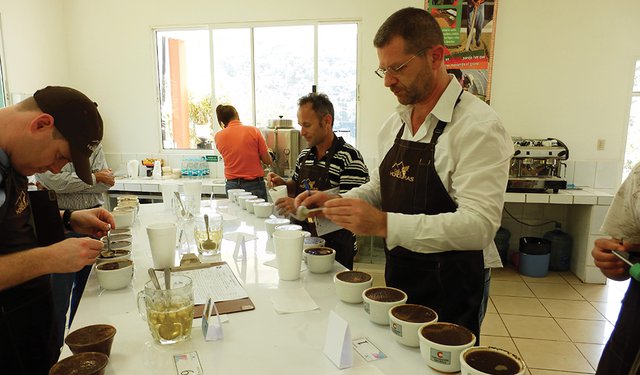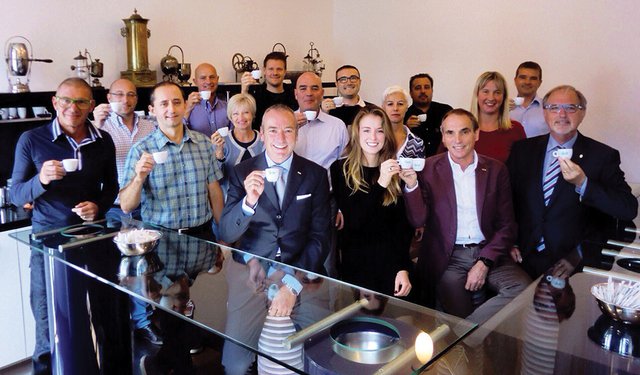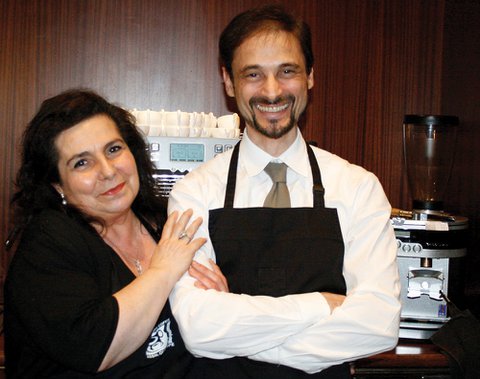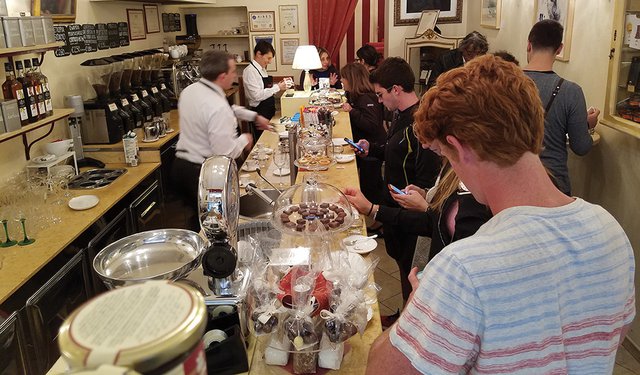Caffé Terzi is a narrow shop with a modest street profile. Inside, a long bar leads from the door to a few tables in the back. Manager Elena Naldi and her staff opened their doors 30 minutes ago and already customers are standing two deep waiting for their morning coffee.
House espressos here sell for 1,10€ ($1.35). Ask for a specialty coffee and on this day the beans will originate from Guatemala, Rwanda, India, or Ethiopia. The price per espresso will be higher, as much as double. Each pull is handmade, unique.
Naldi is in constant motion, producing espresso after espresso. Her Faema machine is working non-stop. No time to talk, she says with a smile.
Caffé Terzi, located near the University of Bologna, is like countless other neighborhood coffee bars. It’s the place Italians typically start their day, energized by the espresso. Yet despite the millions of cups served across the country, few are drinking single-origin arabica as they are here.
“Coffee is a habit for Italians,” says Cristina Caroli, national coordinator for the Specialty Coffee Association in Italy and a café owner herself. “Italians are asking for blends. They are used to blends. They are not asking for something special.”
Specialty coffee shops here are trying to change ways by convincing consumers to try something new. It’s not easy but bars like Caffé Terzi and Caroli’s AROMA are making progress one customer at a time.
A “one-minute pleasure”
The habit starts with the routine espresso, Caroli says. “They don’t think about what they are doing. It is one-minute pleasure. They are runners.”
This pleasure is ingrained in the culture. “Espresso in Italy is strictly connected to our way of life,” Naldi says later. “We start in the morning drinking espresso. Espresso is always present in our breaks, after lunch, and sometimes after dinner.”
Espresso is synonymous with “taking a break,” she says. It’s a private moment shared with strangers standing at the bar. That moment is short and sweet, thanks to a dose of sugar in most cups. And then, just as quickly, it’s over.
Theresa Sandalj agrees. She has been watching the Italian coffee culture evolve nearly her entire life. Her family founded Sandalj Trading Company in 1945 and her father, Vincenzo, was an industry leader. Theresa joined the company in 2013 and she sees an inherent challenge in advancing specialty coffee.
“Italians are gregarious by nature, and most bars are small so one just swings by, says hello, has a quick espresso and heads to work,” Sandalj says. “There are few coffee places where one sits down and has a coffee and a long read. Most of them are shot-and-go.”
And, consumers not only drink their espressos in a hurry, they tend to prefer the local or regional blends and roasts their taste buds recognize. It’s what they expect.
It all adds up. Italians drank 4.78 billion cups of coffee outside their homes in 2015, according to Statista, a statistics portal. That number does not include the countless cups made each morning in ubiquitous household Moka pots.
By comparison, French coffee drinkers consumed 2.27 billion cups of coffee outside the home in 2015. Great Britain totaled 2.1 billion, Germany reached 1.93 billion, and Spain counted 1.77 billion, Statista reported.
It’s easy to find a café. Small bars dot the commercial streets in most Italian cities and towns. Recently released numbers from the SCA reveal Italians spent more than $7.5 billion in nearly 59,000 cafés in 2017. In all, 90% of those cafés are independently owned and operated.

Coffee is a business
The Italian coffee bar industry blossomed in the late 1940s and ’50s. Large coffee roasters, looking for a way to get their products to consumers, began supplying interested small business owners with everything needed to open a café. That included an espresso machine, cups, furniture and, of course, the coffee.
In return, each café owner was committed to only serving that roaster’s coffee, and that coffee was most often a dark roast blend.
The unwitting third party in this arrangement was the coffee drinker who, over time, grew accustomed to the blend. More than a half-century later, specialty coffee advocates are looking for ways to wean them off the dark blends and try something else.
“Coffee is the business. They give you money, furniture and (an espresso) machine. You put on an apron and start. The barista is not invested in the coffee,” Caroli says. “Customers are paying (the business) debt by drinking bad coffee.”
“We have to break these (commercial) rules and go in another way,” she says. “To make quality, we have to invest (ourselves) and be free to choose the best coffee.”
Leonardo Lelli, a Bolognese coffee roaster and an early force in the Italian specialty coffee movement, recalls a major roaster’s advertising campaign years ago that simply said “drink my coffee” yet never explained where the coffee originated and why one should buy it.
“And today it’s the same,” Lelli says. “People all are drinking coffee without knowing what they are drinking. No one explains to the customer.
“We started to drink coffee after World War II,” he says. “Even now, a lot of baristas are not interested in the coffee. The big roasting companies don’t care if you know about the coffee.”
Drinkers do know, however, that if they walk into their favorite bar and place their Euro on the counter, they will receive their familiar espresso. And, Theresa Sandalj says, they “would think we’re being absolutely blasphemous with this talk of specialty vs. bad coffee.”
“What stifles qualitative evolution in Italy is surely price,” she says. “One espresso was traditionally related to the price of a newspaper. Most Italians will not be happy to pay more than €1.00 for either. The expensive cafés go higher, tourist locations go higher, but the typical bar will not.”

More honor, more value
Theresa Sandalj likes to think of specialty coffee as her father described it when he was a founding member of the then-Specialty Coffee Association of Europe. “Strive for quality, sustainability, and culture,” she says. “Care for the product you are selling, the people who are involved in it, and the consumers who will drink it.”
Leonardo Lelli agrees, and says he talks about coffee whenever he can – where it’s grown, how it’s grown, how it’s washed, and how to best roast the beans. “I talk with people on airplanes,” he says. “I tell them coffee was born in Ethiopia, that there is coffee in India. They did not know.”
A recent conversation at his roastery starts with an espresso and, not surprisingly, his description of the beans and the source of origin.
“We need to give the cup of coffee more honor, more value,” Lelli says.
Lelli’s efforts to advance quality coffee in Italy began more than 20 years ago when he worked in quality control for a company producing electronic color coffee bean sorters. He talked with hundreds of coffee roasters across Italy, he says, “and each roasting company told me ‘this is the best coffee.’ That is 800 ‘best’ coffees so I started to think. I need to understand what is the best coffee and why is it the best coffee.”
That research connected him with Vincenzo Sandalj. “And when I met him he gave a sample. It was not a blend,” Lelli recalls. “It was completely different from all the coffee I drank before. To me, all I knew about coffee was cancelled. So, I started again to study.”

Another person in search of coffee enlightenment was Alessandro Galtieri, a cafeteria owner in Bologna.
“[Galtieri] wanted to know a lot more about coffee,” remembers Cristina Caroli, who at that time was a cafeteria customer. She later married Galtieri and together they opened Aroma Caffé.
Galtieri needed a roaster so he turned to Torrefazione Caffé Lelli.
Aroma then took the rare step of offering its customers a coffee menu from which to choose their day’s espresso. People were confused at first and then became “absolutely curious” about the idea of ordering a specific coffee. In time, they began ordering something different each day. They also had to slow down, stop running.
“They had to wait for us to grind,” Caroli recalls. “People came in to see this strange ritual.”
Customers brought friends to the coffee bar to show what they had discovered. Newcomers would repeat the education process – reading the menu, asking questions, selecting and discovering new tastes.
There was a side effect, too. “The runners had to go away. They couldn’t wait. They didn’t come twice,” she says.

Things are starting to change
A growing legion of café owners and baristas are showing fellow Italians they don’t have to drink lesser quality coffee. SCA’s Italy chapter totals 135 businesses and approximately 700 members, and each person tries to raise awareness.
“Now things are starting to change and people are beginning to research quality in what they are drinking,” Naldi says. “Specialty coffee is a philosophy that involves all the people from the farmer up to the final consumer.”
Converting customers is not easy. It requires a wholehearted commitment by the café and each barista behind the bar. Each interaction is an opportunity.
“You have to respect the quality coffee chain,” Caroli says. “We spend the time and energy to make people curious. We want them to ask ‘Why is this [café]atmosphere so different? Why is this coffee so good?’ You have to change their mind on coffee. If we don’t do our best, we break this chain.”